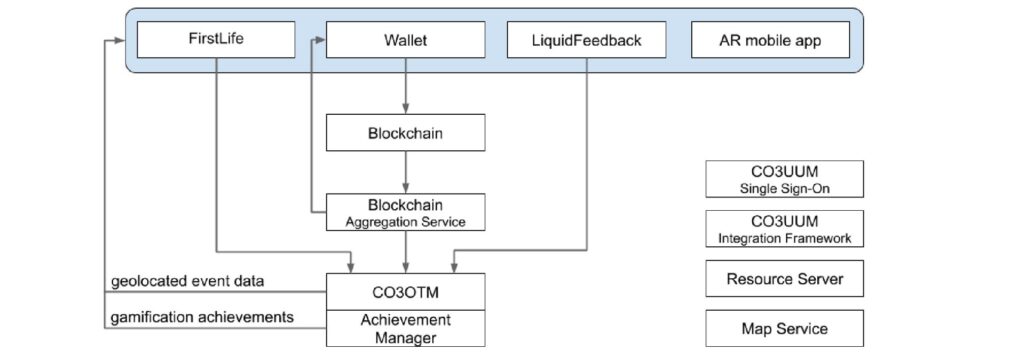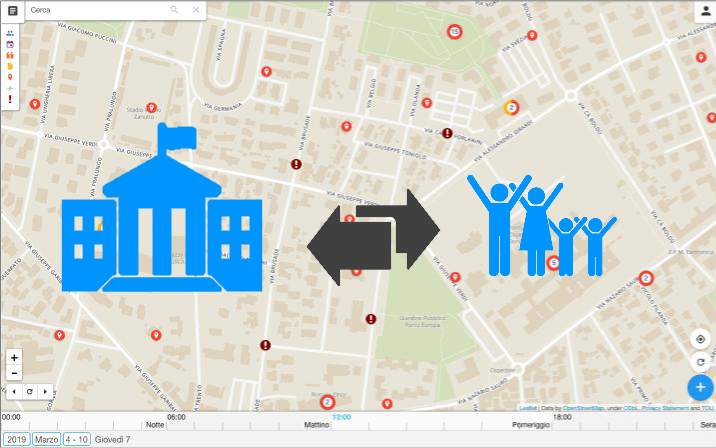Policy analysis
Implementing disruptive technologies at the CO3 project is translated into a platform composed of several modules, each of those implementing several toolkits, frameworks, and protocols. Some of the modules used in CO3 come from previous developments. The handicap is to modify and integrate additional services and protocols to enable the modularity and let certain independence for each partner to add additional functionality and update the tool that they provide inside the CO3 platform having the lowest impact as possible in terms of development changes to the other partners that use/consume the functionality provided by their tool.

Figure 1 The essential technologies developed/used inside the CO3 project.
The technical experts have chosen two approaches to enable interoperability. For the user interface side, we have the WebViews, which are embeddable components inside a parent interface. In the case of the CO3, it’s determined by a “LandingPage” in the web version that integrates the main toolbar with the basic user’s session management and the different buttons to change the view to LiquidFeedback, FirstLife, and the blockchain wallet. In terms of the CO3 AR APP, there is a three tabbed-based interface developed in UNITY which allows the user to change between the AR interface, FirstLife, and the blockchain wallet.

Figure 2 Architecture of the data flow between the CO3 modules.
Technical speaking, the CO3 platform comprises nine modules: four are entirely graphically visible by the end-user, and the other six are parts of graphical interfaces and APIs. In a technical view, the CO3 platform is composed. Figure 2 indicates the different modules inside the CO3 platform, highlighting in blue the graphical visible interfaces. The arrows indicate the data flow.
Lessons learned: recap
Policy implications
Every day we see how applications make use of AR mechanisms for our entertainment. We see how many citizens use it naturally and talk about how powerful their new mobile device is. We also see how there are mechanisms for exchanging tokens in the form of coupons through points programs at some stores from a long time ago, and the users understand the mechanisms. There are also interactive, democratic mechanisms implemented at some websites where a product or a person is being voted on. All these details indicate that adopting any of these technologies should be something simple and easy to comply with when it comes to the common citizen. The point is those cases are particular, small scale and stand-alone applications.
However, in the CO3 integrated case, we have found some barriers where we make some recommendations in order to improve the adoption of the technology into the different users and associations:
- Provide an application walkthrough/course: Citizens are open to exploring new technologies and adapting to new services and applications, but the usability and ease-of-use of new technologies are proportional to their adoption level. This is why each platform’s module could include an interactive tutorial (walkthrough) that shows the basic functionality to anyone who uses the CO3.
- Persuade local organizations/administration: Convince local organizations that the CO3 co-creation mechanisms do not put their form of government at risk but rather complement it. Show them examples of new forms of co-management.
- Scale depending on the device: make adjustments to the CO3 platform software to different devices, providing the technology according to the device you have and not the other way around. If it is impossible to offer an AR environment, provide basic services based on geolocated map technologies and user geopositioning.
- Regulated transactions: Provide different methods for converting credits (real money) to tokens and vice versa compatible with the legislation. Due to financial regulations, it may be necessary to report transactions in the CO3 blockchain system to avoid government impediments.
- Choosing the public: Before implementing CO3 in an extended way to all the pilots’ users, it would be convenient to gather their expectations to decide the use cases they want to test in that group. Since through co-production, new forms of interaction are explored, as well as new limitations.




